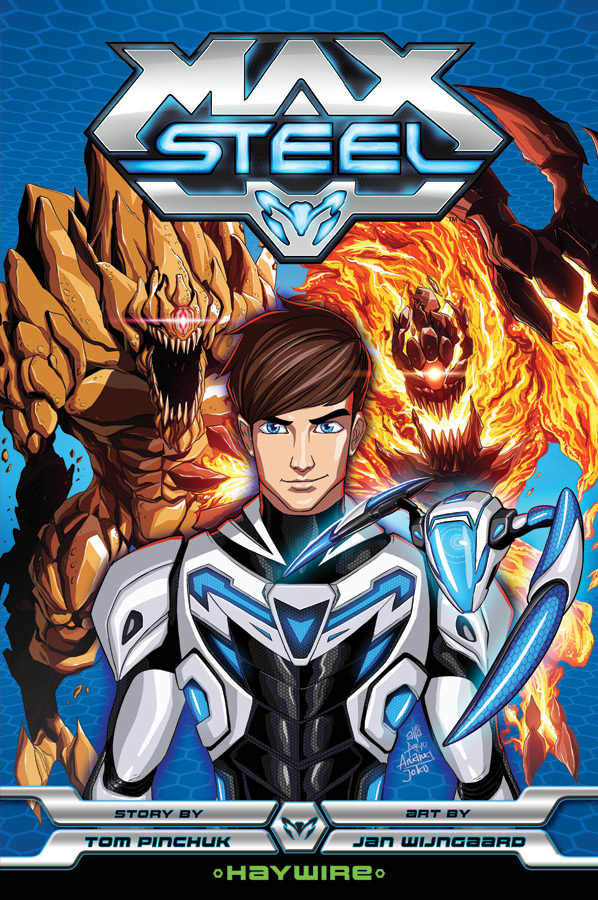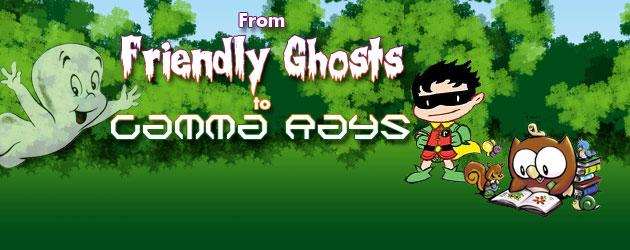From Friendly Ghosts To Gamma Rays, No.171
Hey ya’ll and welcome back to our all-ages comics column, From Friendly Ghosts To Gamma Rays! This week we have an interview with writer Tom Pinchuk, who just worked as writer on the Max Steel title from Viz Media’s Perfect Square imprint! Let’s pick his brain!
—————————
 ComicAttack.Net: So to start, Tom, of all the things you could have done in life, how’d you get into doing comics?
ComicAttack.Net: So to start, Tom, of all the things you could have done in life, how’d you get into doing comics?
Tom Pinchuk: Gee… the chicken, or the egg?
Honestly, it’s something that goes so far back, I can’t remember ever consciously choosing it. I was always acting out stories with my action figures, and drawing little comics with my markers.
When my first grade teacher asked me what I wanted to be when I grew up, I proudly declared “comic book writer.”
CA: How’d you end up writing the new Max Steel comic?
TP: I’ve been working in comics for a few years, but it’s mostly been on independent, mature reader titles. That work got the attention of Man of Action Studios, and they invited me to write for them on an animated series they’re producing.
That was about a year or so ago. The timing worked out nicely because, around the same time, VIZ Media was launching this new imprint to publish all-ages books based on American cartoons. One of the editors, Joel Enos, had known me from my comics. We’d wanted to work together, but it wasn’t until I had the animation work in my CV that he could make the case for me being a good fit on a title like this.
So, it was a multimedia Mobius strip – – comics led to animation, which then led back to comics.
CA: Max Steel has a lot of things in there that can be compared to so many titles. We have robotic suits, element themed aliens, and more. It feels somewhere between American Saturday morning and Japanese animation in terms of the world blend. How was this world for you to explore and what called out to you?
TP: When I first got the licensors’ guide, I was just struck by how sleek and futuristic all the suits and armors looked. It seemed almost like the Warren Ellis revamp of Max Steel.
 Once I dug in further, it was Max and Steel’s buddy dynamic that spoke to me most. You’ve got this classic teen superhero, with all the problems that come with having a secret identity; but he’s carrying this biomechanical smart alec around all the time. They could journey to the farthest reaches of the galaxy and still be busting each other’s chops. Those are the guys I want be with if I’m ever meeting an evil Ultra-Link or a monstrous Elementor.
Once I dug in further, it was Max and Steel’s buddy dynamic that spoke to me most. You’ve got this classic teen superhero, with all the problems that come with having a secret identity; but he’s carrying this biomechanical smart alec around all the time. They could journey to the farthest reaches of the galaxy and still be busting each other’s chops. Those are the guys I want be with if I’m ever meeting an evil Ultra-Link or a monstrous Elementor.
CA: Your writing on Max Steel has a nice flow; what was your favorite part writing this comic?
TP: Favorite part on the broader sense? Working on this really put me back in touch with what storytelling was like in my earliest days. It felt just like being back in that playroom, with a big box of action figures from Mattel. Only this time, I was writing down the stories I put these toys through.
Favorite part of the comic itself? There’s a scene where Max, Steel, and their commander, Forge Ferrus, are trying to sneak into the Elementors’ lair. They’re working out this elaborate tactical plan, trying to keep things covert and then… UH-UH! The bad guys just knock a wall down right over them. There goes your fancy plan.
Having all these knuckleheads lock horns constantly, and ‘prank’ each other like that, really never got old.
CA: You’ve worked on the Ben 10 TV series, correct? How is writing a TV episode different from writing a comic?
TP: Actually, I’ve worked for Man of Action Studios on another TV series they’ve produced. They created Ben 10, but this wasn’t Ben 10 itself.
The two major differences are description and pagination. Sounds so academic, right?
‘Description’ meaning that when you’re writing a comics script, you really ought to describe what’s happening in each panel, in detail. In animation, more of those decisions are left to other hands in the crew, so the script’s expected to be leaner. You describe what’s happening in general terms.
‘Pagination’ is a huge part of the ‘invisible art’ in comics. There’s a general range for animation scripts’ length, but you still have wiggle room to run over or under a little. In a comic script, you’re bound to far more rigid parameters. An issue must be 22 pages, right? If I add a two-page scene here, I must remove two pages there, and vice versa. It gets even more complicated when you’re dealing with two-page spreads. You’d hate to see a beautiful double splash get split up by a page turn. These are concerns you constantly need to consider in comics.
CA: For a few decades now toy lines with an animated series and comic book tie-ins have become a staple, both for toy manufacturers and the legions of fans that grow to love them, from He-Man all the way to Max Steel. How do you think the Max Steel comic and approach is different from the others in the past?
TP: Well, this Max Steel is quite different from the previous iteration that ran about ten years ago. Max was a grown-up spy in that one. Now, he’s a teen superhero battling aliens.
In respect to the larger tradition of toy-based series? I can’t immediately recall any that centered on a partnership the way this does. It’s called Max Steel, but it’s really Max & Steel. Max can’t switch to any of his Turbo Modes unless Steel is there to facilitate the change. Likewise, Steel doesn’t pose any kind of threat to the bad guys on his own. The duo is that symbiotic.
CA: Although you didn’t work on it, but worked for them, let’s still ask: Ben 10 and Max Steel get into a fight, who wins?
TP: We’d all win. That’d be an awesome fight to watch.
CA: Any final thoughts for our readers?
TP: Always believe.
————————————————————-
That’s it for this week! We thank Tom for joining us! See you in two weeks when we are back!
Drew McCabe
drew@comicattack.net

